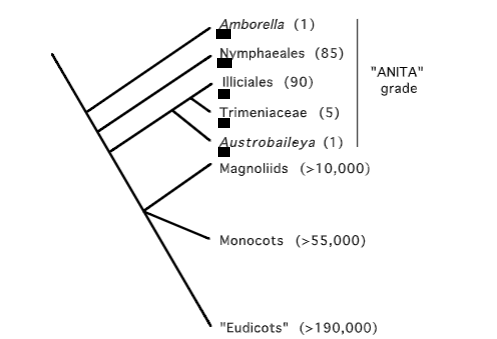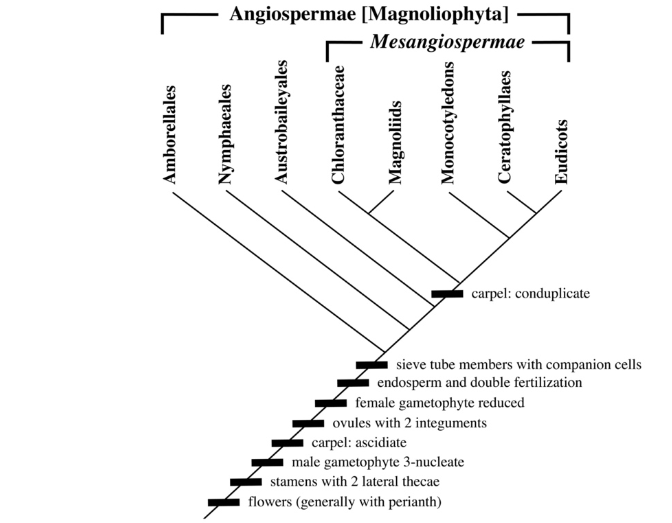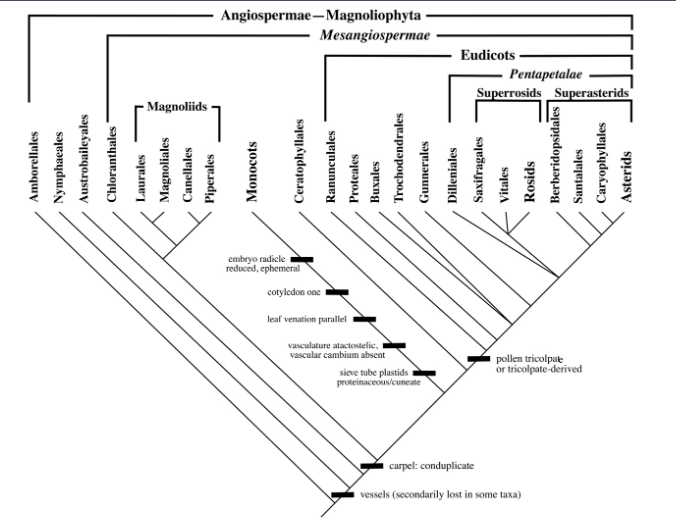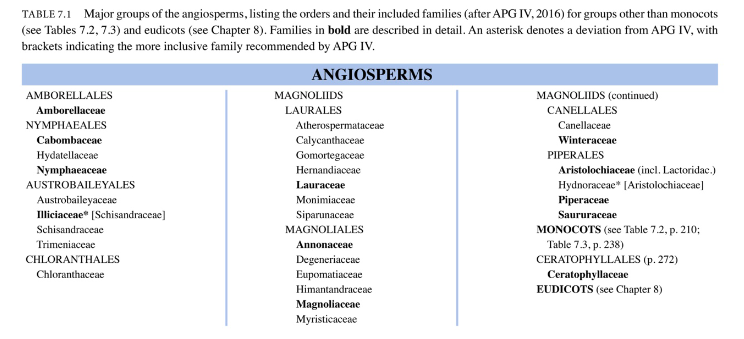Origin of Angiosperms
1/19
There's no tags or description
Looks like no tags are added yet.
Name | Mastery | Learn | Test | Matching | Spaced |
|---|
No study sessions yet.
20 Terms
clearly derived features/characteristics of angiosperms (5)
carpels
stigmatic pollen germination
reduced gametophytes
endosperm
double fertilization
delay investment
carpels
megasporophylls that are infolded and enclose the ovules (immature seeds)
provide protection to ovules
stigmatic pollen germination
germination occurs on the stigma rather than directly on the ovule
allows for greater selectivity of reproductive partners by maternal parent
reduced gametophytes
microgametophytes = pollen tubes
only 3-celled at maturity, a tube cell, and 2 sperm cells
megagemtophytes
7-celled, 8-nucleate embryo sac
endosperm
a nutritive tissue that develops from a second fertilization event
one of the two sperms from the pollen tube unites with two polar nuclei of megagametophyte
double fertilization
involvement of both sperms in fusions with different cells of the megagametophyte
angiosperms __________ __________ in nutritive tissue for each embryo until fertilization is assured
delay investment
Darwin’s abominable mystery
The mystery was how to account for what appeared to be a sudden appearance of modern angiosperm families in the Cretaceous. Transitional fossils appeared to be absent.
Today, there is still no evidence of verifiable angiosperm fossils before the early Cretaceous. Why?
Fossil evidence suggests that angiosperms rapidly displaced other groups of seed plants during the Cretaceous.
The fossils from the early Cretaceous show evolutionary transitions in leaf and pollen characteristics. What does this mean?
Modern angiosperms do not suddenly appear.
Until recently angiosperms were widely believed to be the sister group of ____________ based on preliminary molecular and morphological phylogenetic analyses.
gnetophytes
More recently, phylogenetic results from multiple-gene analyses provide more support for a sister-group relationship between ___________ and _________.
gnetophytes and conifers
both share various morphological features, such as compound seed cones
5 major groups of seed plants
cycads
ginkgos
conifers
gnetophytes
angiosperms
ANITA grade
Amborella
Nymphaeales
Illiciales
Trimenia
Austrobaileya

The features below are shared by some or all of the different lineages of the ANITA grade and are therefore suggested to have been features found in the most recent common ancestor of all living angiosperms:
Two cotyledons (dicots, not monocots)
Uniaperturate pollen (not triaperturate)
Carpels sealed by secretions (not fused); ascidiate (barrel-shaped)
Lack of differentiation of sepals and petals (tepals)
Indeterminate (variable) numbers of tepals, stamens, and carpels
Spiral arrangement of floral parts
Lack of fusion of floral parts
Self-incompatibility = pollen cannot fertilize ovules from the same plant
No vessels (but other vessel-less angiosperms (e.g., Winteraceae) evidently represent a loss of vessels)
Occurrence in sporadically disturbed sites in shady forest understories ("Dark and Disturbed" ecology)



Early Angiosperms covered in basal angiosperm lab
Amborellales
Amborellaceae – Amborella family (Amborella trichopoda). 1 genera/1 species.
Nymphaeales
Cabombaceae
Cabomba caroliniana (fanwort)
Brasenia sherberi (water shield)
Nymphaeaceae
Nymphaea odorata (Water-Lily)
Nuphar advena (broad leaf pond lily)
Nuphar variegata (Bull-head lily)
Austrobaileyales
Illiciaceae
Illicium floridanum (Florida star anise)
Magnolids covered in basal angiosperm lab
Laurales
Calycanthaceae
Calycanthus floridus (sweet shrub)
Lauraceae—Laurel family (L. laurus, laurel or bay). 45 genera / 2200 species.
Sassafras albidum (sassafras)
Lindera benzoin (Northern spice bush)
Persea (avocado)
Magnoliales
Annonaceae—Custard-Apple family (Anona, a Haitian name). 112 genera / 2150 species.
Asimina triloba (Pawpaw)
Magnoliaceae—Magnolia family (after Pierre Magnol of Montpellier, 1638–1715). 7 genera/200 species.
Magnolia grandiflora (flowering magnolia)
Magnolia fraseri (mountain magnolia)
Magnolia macrophylla (big leaf magnolia)
Lirodendron tulipifera (tulip tree)
Piperales
Aristolochiaceae - Birthwort family (Gr. aristos, best + lochia, childbirth, from resemblance of a species of Aristolochia to the correct fetal position). 7 genera / 410 species.
Aristolochia sp.
Asarum canadense (Canadian Wild Ginger)
Piperaceae—Pepper family ( piper, Indian name for pepper). 14 genera/1940 species.
Peperomia (Peperomia)
Piper sp. (pepper, stem in slide only)